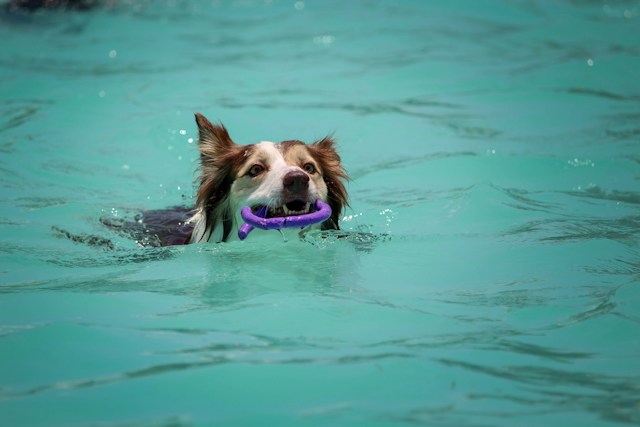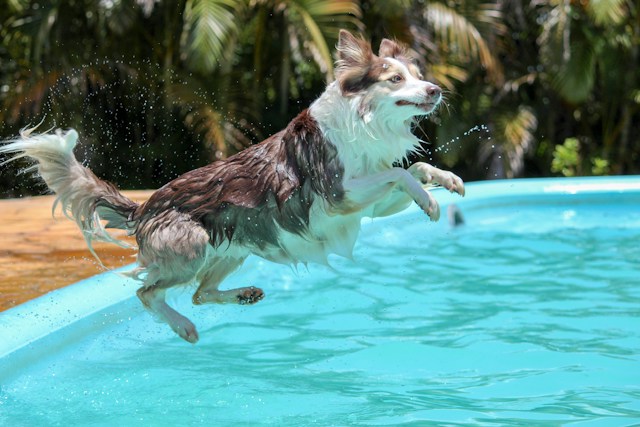Introduction: Dogs are known for their love of water, whether it’s a playful splash in a pond or a refreshing swim in a pool. But when it comes to chlorine pools, pet owners often wonder whether it’s safe for their furry friends to take a dip. Chlorine is a common chemical used to disinfect swimming pools, but its effects on dogs can raise concerns. In this blog post, we’ll explore the question: can dogs swim in chlorine pools? We’ll delve into the potential risks, safety precautions, and tips for ensuring a safe swimming experience for your canine companion.

Understanding Chlorine and Its Effects on Dogs: Chlorine is widely used in swimming pools to kill bacteria and other harmful microorganisms, making the water safe for human swimmers. However, dogs have different sensitivities and vulnerabilities compared to humans, so it’s essential to consider how chlorine might affect them.
Exposure to chlorine can irritate a dog’s skin, eyes, and respiratory system. Prolonged exposure or ingestion of chlorinated water can lead to more severe health issues such as gastrointestinal upset or chemical burns. Additionally, some dogs may be allergic to chlorine, further complicating matters.
Factors to Consider Before Allowing Your Dog to Swim in a Chlorine Pool: Before letting your dog take a dip in a chlorine pool, consider the following factors:
- Dog’s Health: Evaluate your dog’s overall health and any pre-existing conditions that may be exacerbated by chlorine exposure. Dogs with sensitive skin, respiratory problems, or allergies may be more susceptible to adverse reactions.
- Chlorine Levels: Test the chlorine levels in the pool water regularly to ensure they fall within safe ranges. High levels of chlorine can be harmful to both humans and dogs, causing irritation and other health issues.
- Pool Maintenance: Proper pool maintenance is crucial for ensuring water quality and safety. Regularly clean the pool, remove debris, and maintain appropriate chemical levels to minimize health risks for your dog.
- Supervision: Always supervise your dog while they’re swimming in a pool, regardless of whether it’s chlorinated or not. This helps prevent accidents and ensures your dog’s safety at all times.

Safety Precautions for Dogs Swimming in Chlorine Pools: To mitigate the risks associated with swimming in chlorine pools, take the following safety precautions:
- Rinse Before and After: Before allowing your dog to swim in a chlorine pool, rinse them off with fresh water to remove any dirt, debris, or potential irritants from their fur and skin. After swimming, rinse them again to wash away residual chlorine.
- Limit Exposure: Limit the amount of time your dog spends in the pool to prevent overexposure to chlorine. Monitor their behavior for signs of discomfort or distress, and promptly remove them from the water if necessary.
- Protective Gear: Consider outfitting your dog with a canine life jacket or protective swimwear to provide additional buoyancy and protection while swimming. This can also help minimize chlorine exposure to their skin and fur.
- Fresh Water Access: Provide your dog with plenty of fresh water to drink before and after swimming to prevent dehydration and flush out any chlorine they may have ingested.
- Watch for Signs of Distress: Be vigilant for signs of chlorine poisoning or irritation in your dog, such as coughing, wheezing, redness, swelling, or excessive scratching. If you notice any concerning symptoms, seek veterinary care immediately.

Conclusion: While dogs can technically swim in chlorine pools, it’s essential to proceed with caution and prioritize their safety and well-being. Consider your dog’s health, monitor chlorine levels, and take appropriate safety precautions to minimize the risks associated with swimming in chlorinated water. By following these guidelines and being attentive to your dog’s needs, you can ensure a safe and enjoyable swimming experience for your canine companion.

